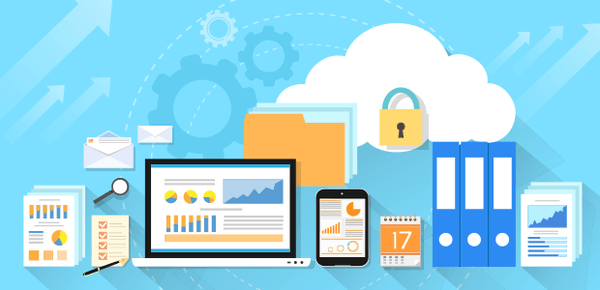
The Benefits of Outsourcing Your IT Needs
June 10, 2020
Using Excess Heat from Data Centers to Heat Residential Areas
June 15, 2020Backup and Disaster Recovery (DR) are both integral parts of business continuity in this time and age. While they are becoming used interchangeably, these are two very different components of protecting your system. Backups create a point-in-time replica of your files. In the event of an IT disaster, you can simply return your system to its previously saved state. Disaster Recovery plans, on the other hand, refer to a set of procedures and protocols to keep your workload running from a remote location to keep your operations afloat in the time of a disaster.
With their difference stated, it is important for managed IT services providers to understand that while they are separate plans and procedures, they are not mutually exclusive. A disaster recovery plan in place does not excuse you from regularly backing up your files. Backups keep your organization safe in the event of denial-of-service, accidental deletions, or ransomware attacks. DR plans to protect your mission-critical workloads from infrastructure failure, like virtualization host cluster failure events.

Credit: Information Age
To keep your data and your workload safe in the event, here are some of the best practices in the industry you can consider for your company.
Acquire Disaster Recovery as a Service (DRaaS)
For smaller businesses or organizations without in-house IT expertise, outsourcing your DR is not a bad idea. DRaaS are offered by healthcare cloud companies where cloud resources are used to protect your applications and data in the event of a disaster. Since a virtual copy of your system is available online, it goes into action and keeps your mission-critical workloads afloat in the event of an IT disaster. In regular operations, your in-house infrastructure handles your processes. In the event of a failure, however, a secondary virtual copy stored in the cloud takes over and makes sure that you maintain operations without fail.
DRaaS offers a lot of advantages in keeping your important processes in the event of a failure. Since it is hosted on the cloud, you can rely on it to be available anytime and it can immediately cover in the event your physical infrastructure is left unavailable. Also, it is flexible in serving different configurations across different platforms so implementing DRaaS as a part of your plan is easy and fast.
Right now, the market for DRaaS is fairly segmented, with multiple players sharing the market almost closely with each other. You might want to do more research or make more inquiries to see which provider can best help you with your organization’s exact needs.
Utilize Secondary Data Protection Methods
The building blocks of data protection usually include backups, snapshots, and replicas. Backup has been earlier defined as a point-in-time copy of your files and settings you can reload in the event of a failure. Snapshots are reference markers for your data for every defined point in time, creating a copy of your machine’s disk file.
Replication, on the other hand, regularly makes copies of important virtual machines and applications. Usually, replication tools also leverage snapshots, except that when a segment of data changes, those changes are replicated to another system or site instead of on top of the same system.
The considerations for this practice has to be weighed properly since it will include significant investments for secondary or even tertiary storage devices and data banks.
Start Automating Your Backups with Appliances
Another rising backup technique over the past years involves the use of software-defined appliance-based methods using geo-redundant cloud copies. It allows your organization to enjoy automatic backups to keep them ready and accessible, regardless of the nature of the IT disaster you might experience. Your files are backed up onto multiple off-site data centers, keeping it safe and isolated from your own environment while keeping it online and available for your use.
Again, not all backup appliances are created equal. You might want to take a second look at what each solution provider offers in terms of both software and hardware. The database engine should employ the latest tech and allows for database expansion into large sizes to make sure it will cover your operations for a good period of time. Lastly, appliance software now has to only backup a file once. Requiring you to periodically start all over again still employs old tech without a relational database and will cost you time and money down the road.
Generate a Business Continuity Plan (BCP)
Every businessman knows that for each minute the business is on hold, it equates to large amounts of cash going right down the drain. In fact, Gartner, a research and advisory company, assesses that losses due to IT downtime averages at about 5,600 USD per minute and can go as far as 300,000USD per hour.
In their report, they detail that 98% of the organizations surveyed pegged their losses at more than 100,000USD per hour of downtime, 81% of which specifically notes that the same hour of downtime costs them more than 300,000USD. The only option to avoid this disastrous scenario is preparation. And even then, it does not perfectly eliminate the risk of downtime, only that it can save your most mission-critical processes and reduce the downtime you are looking at.

Credit: Commvault
Unfortunately, the use of business continuity plans is not as commonplace as we would like to think. The insurance carrier Nationwide published their findings that as much as 68% of small business owners do not have a documented disaster recovery plan. More than just winging it when disaster strikes, it is important to have a comprehensive plan that all levels in the organization can follow and understand.
In developing your company’s business continuity plan, understand that its main objective is to keep your business afloat and operational in the event of any untoward circumstances. Identify the scope of your plan, the key areas in your business, and the critical business functions that will take priority.
Also, you will have to conduct studies on the costs your organization will face for every minute of downtime and try to generate an acceptable period using measurables such as Recovery Time Objectives (RTO) and Recovery Point Objectives (RPO). In the end, a well-developed BCP will help you protect your company and prevent thousands of dollars in potential losses.
However, you go about it, covering both fronts is a win-win situation for you and your company in this age of relentless malware attacks and aging hardware. The downtime and the subsequent costs and operational interruptions should illustrate how essential these preventive measures are. With the right choices, you can definitely prepare a fail-safe plan to protect your important digital assets.
Main Photo Credit: GCN

